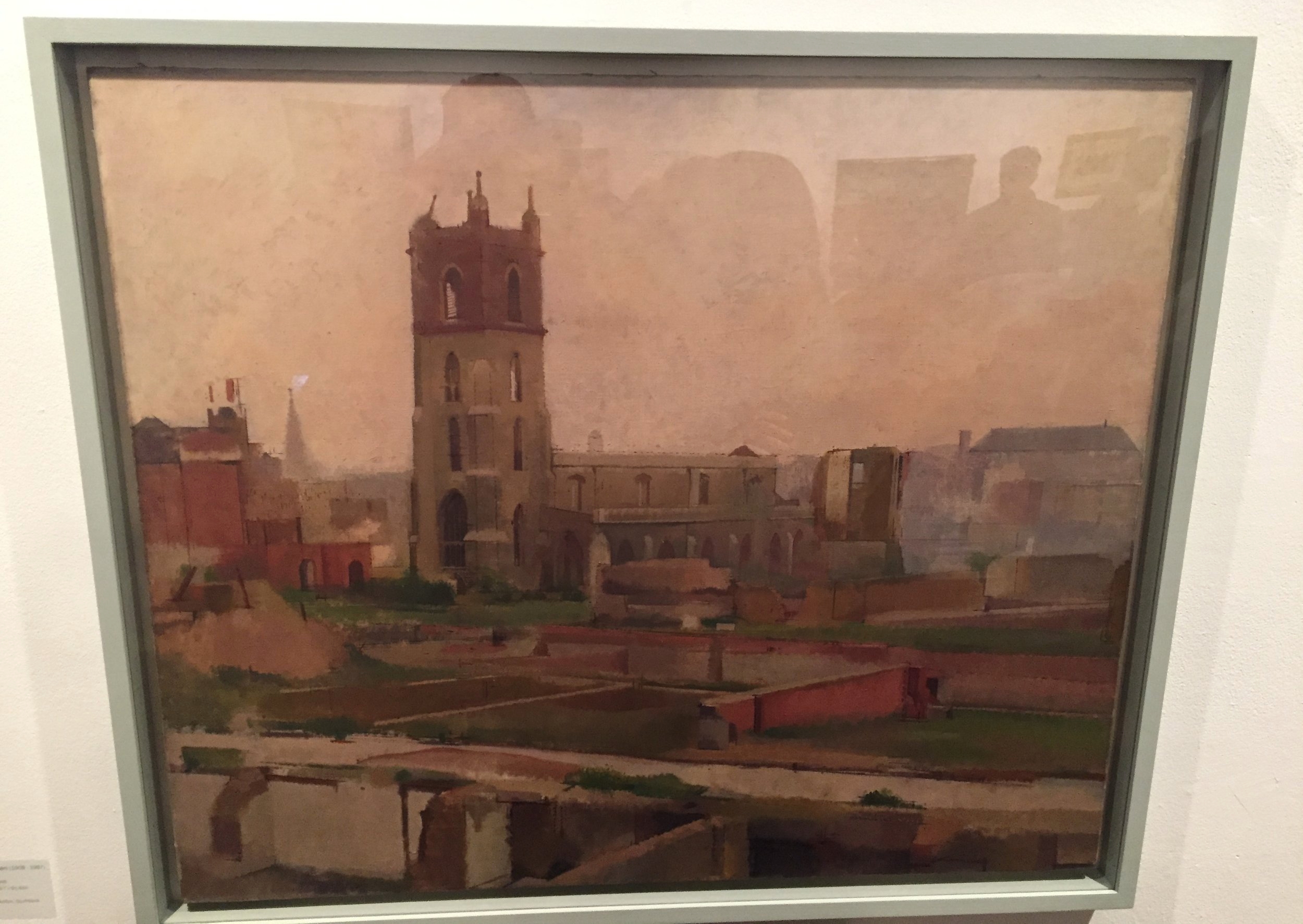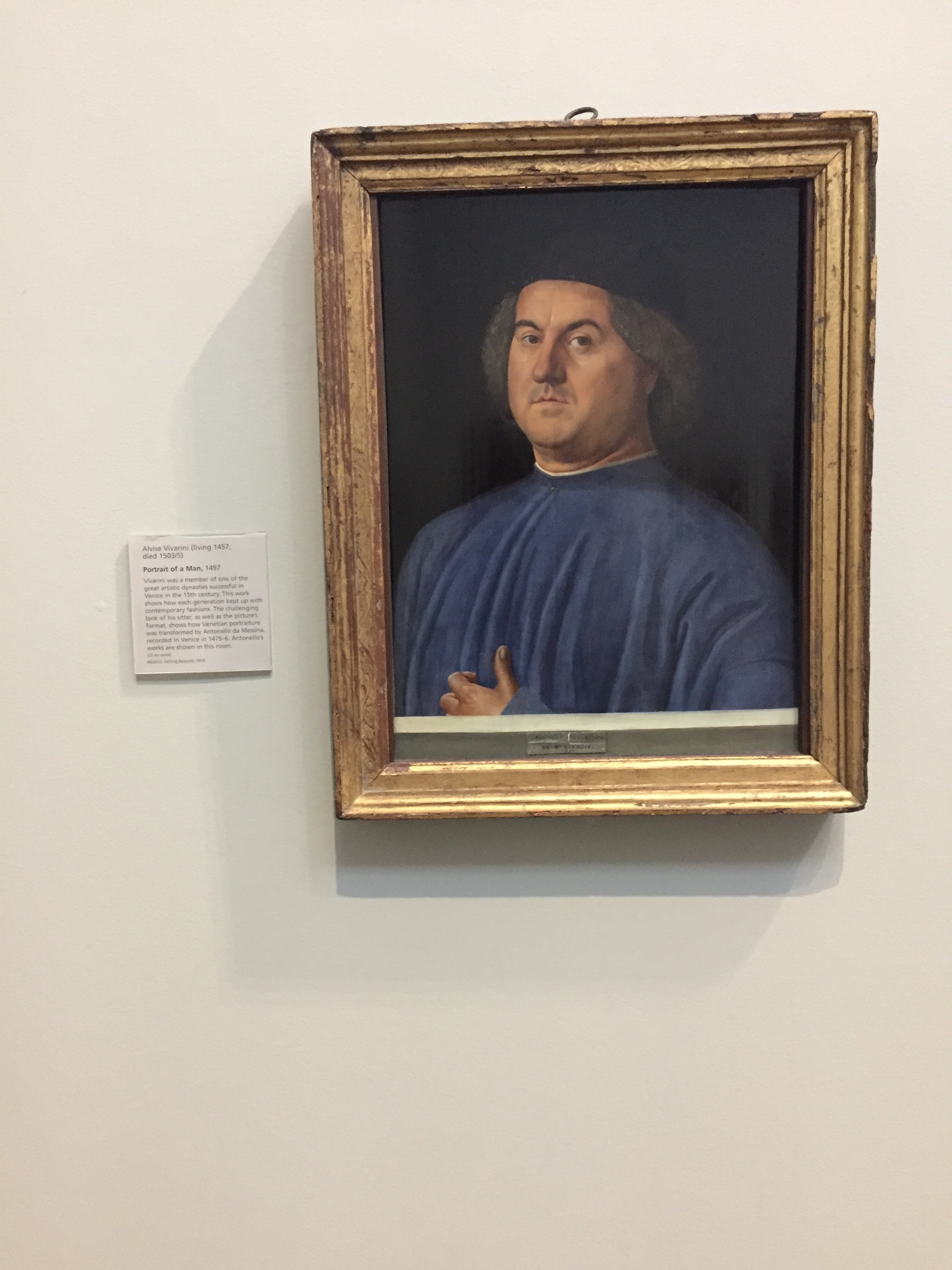The Working Artist: The East London Group /
At the opening for The Working Artist: East London Group at the Nunnery gallery. The exhibition includes artworks by William Coldstream, Elwin Hawthorne, Brynhild Parker, Harold Steggles, Walter Steggles and Albert Turpin.
Working during the inter-war period, the thirty-five members of the East London Group were taught by artists including Walter Sickert. They made and exhibited their paintings alongside their day jobs.
Works by Albert Turpin.
Cripplegate, William Coldstream. Oil on canvas, 1946
Charles Booth's Descriptive Maps of London Poverty /
Bomberg lived with his family on St Mark’s street in the Tenter Buildings from 1896.
The Bishopsgate Institute has reprinted copies of Charles Booth’s Descriptive Maps of London Poverty from 1889 and are an early representation of social cartography. Each street in London is colour coded to describe the income and social class of its citizens.
Black: The lowest class, Vicious, semi-criminal
Dark Blue: Very poor, casual. Chronic want
Light Blue: Poor, 19 to 21s. A week for a moderate family
Purple: Mixed, some comfortable others poor
Pink: Working class comfort, Red well-to-do (one to two servants)
Yellow: Wealthy (three or more servants).
St. Marks street was largely classified as Pink - working class with some Purple areas adjacent indicating that Bomberg grew up in a mixed to working class area.
Fat Man of the Renaissance /
David Bomberg wrote in the 1914 Chenil Gallery catalog:
'I appeal to the Sense of Form. In some of the work I show in the first room, I completely abandon Naturalism and Tradition. I am searching for an Intenser expression. In other work in this room, where I use naturalistic Form, I have stripped it of all irrelevant matter. I look upon nature, while I live in a steel city. Where decoration happens, it is accidental. My object is the construction of Pure Form. I reject everything in painting that is not Pure Form. I hate the colours of the East, the Modern Mediævalist, and the Fat Man of the Renaissance.'
Richard Cork on the founding of the Borough Group /
p.270
Dorothy Mead, [one of the founder members of the Borough Group], later recorded that ‘the Borough Group started in 1946’, and she explained that it was formed ‘to further the aims of David Bomberg and to establish his students as professional painters’. At first, Bomberg preferred to see himself as only teacher and adviser, letting Cliff Holden assume the role of President and refusing to include his own work in the Group’s first exhibition. But Holden emphasized its fundamental indebtedness to Bomberg’s example by explaining afterwards that ‘all of us were dedicated people, who had consciously, not accidentally, sought out Bomberg as the only hope of salvation in British painting at that time.’
p.274/275
In December 1947 several of the painters who had participated in the first Borough Group survey – Holden, Mann, Mead and Richmond – contributed to an exhibition at the Everyman Cinema in Hampstead. But it was not, this time, an official Borough Group event, and the addition of Leslie Marr and Dinora created dissension among the other participants. Lilian, who had exhibited in the first Borough Group show and also displayed her work at the Everyman, found herself in an uncomfortable position. So did Bomberg, torn between loyalty towards his own family and a sincere regard for his other pupils at the Borough. When Holden resigned from the Borough Group’s presidency, Bomberg realised that he should now attempt to heal the wounds by establishing the group with a written constitution and becoming the new President himself.
His intervention was successful. At a meeting in January 1948, a formal list of the Group’s members was drawn up. Apart from Lilian and Dinora, they encompassed Holden, Mann, Marr, Mead, Len and Dorothy Missen and Richmond. They were all happy to stay together now that Bomberg had at last assumed leadership, and within a month Marr invited the Group to show its work on a permanent basis at The Bookworm, his bookshop in Newport Court.
Dinora Mendelson on the formation of the Borough Group /
When I married Leslie [Marr] in 1948, Holden, his then partner, Dorothy Mead and a few others formed a group against us, compounded later that year when Leslie took the family to Cyprus on a painting expedition. We all painted well and David’s works were superb. But the trip further incensed Holden and Mead and their reactions fatally damaged the Borough Group.
There was and could only be one President of the Borough Group, David Bomberg. Holden’s claims to be President are untrue.
2005 Tate Archive
Leslie Marr on the Formation of the Borough Group /
The Borough originated in 1946. At first it had no constitution, and no elected officers, and consisted of four of David Bomberg’s original students, who banded together with the intention of exhibiting, and also promoting Bomberg’s work. Dorothy Mead has said, “The Borough Group started in 1946.. to further the aims of David Bomberg and to establish his students as professional painters”, and Cliff Holden has written, “in 1946, under Bomberg’s guidance, a few of us founded the Borough Group. In the beginning it was composed of six students’
(In the beginning it was composed of only four students, Cliff Holden, Dorothy Mead, Edna Mann, and Peter Richmond. A year later Lilian Bomberg and Christine Kamienieska joined, bringing the number up to six.) Holden has claimed ot have been the first president, and although Lilian Bomberg denied this, pointing out that the first gropu had no elected officers, the following statement from Holden would seem to confirm that this was so, ‘Because I was most active in conceiving and fostering the group, Bomberg proposed that I should be first President..’
After the Everyman exhibition Bomberg indicated that the group must now be put on a proper footing with a constitution drawn up, officers appointed, and new members elected. He called a meeting in February 1948 and announced he would assume the presidency and would include his own work in future exhibitions. Cliff Holden writes, ‘At this meeting in 1948, which was chaired by Bomberg, there was a disagreement about the direction the Borough Group should take. Some of us objected to Bomberg bringing in his family, and people that even he thought amateurs. I was certainly supported in my position in this issue by Dorothy Mead. I believe that Peter Richmond agreed with us but he was perhaps less inclined to take a firm stand. However Bomberg took the initiative, and so the group was enlarged.’
Thus the elected members of the now formally constituted group, were as follows: David Bomberg as President, the original members, Lilian Bomberg, Mead, Mann, Holden, Richmond and new members, Dinora Mendelson, myself, Len and Dorothy Missen.
At the end of the meeting Bomberg said that this was a new start, and now that the group was properly constituted, all of the ten elected members were to be designated Founder Members. Bomberg added that he hoped that from this beginning the group would attract more members and grow, but in the event, only one more member, Dennis Creffield, was elected before the group was dissolved in early 1950.
Ever since this meeting a disagreement has existed between Holden and myself over the question of founder members… It appears that Holden considers only the original four students to be the ‘real’ Borough Group, and, very clearly, from many references in his subsequent writing, ..resented ‘the family’.
However – regarding ‘founder membership’ – a manuscript in Bomberg’s hand in the Tate Archive, a press release for the opening of the Bookwork Gallery exhibition, written in the third person, states “Mr Bomberg, the founder of the group, will attend.. to give representatives of the press..” So it would seem that we were all co-founders under Bomberg’s leadership.
Leslie Marr, The Borugh History
Lillian Bomberg (Lilian Holt) on the Founding of the Borough Group /
Out of the crusading enthusiasm for David’s teaching at the Borough, a nucleus of three students and myself was formed to exhibit at the Everyman Cinema Foyer, Hampstead. This exhibition had originally been offered to David, who declined, then it was offered to Leslie Marr, who felt he was not ready as an artist for a one-man exhibition, and offered it to us, Edna Mann, Dorothy Mead and myself. A short time before this, we four artists, decided in joint discussion with the Master David Bomberg, at at the time on the way home from the Borough on the title, ‘The Borough Group’. David and I had previously discussed this, as I have no doubt the others had, but at that time, other than a group to show work, there was no form, no constitution, no secretary, no Treasurer, and certainly no President, as incorrectly published in the Art News and Review.
The first President was David Bomberg, and he was elected in 1947 when the group was properly formed out of the group of artists then working and exhibiting together,
Edna Mann, Dorothy Mead, Lilian Holt (myself, wife of the Artist), Clifford (companion of Dorothy Mead), Dinora Mendelson (daughter by my first husband), Leslie Marr (whom she married), Dorothy Missen, Len Missen. Don Bradman (who married Edna Mann..) opted out of joining the group. A guest artist, Alan Stokes, a student at Borough at the time, exhibited with us once.
Tate Archives, undated






